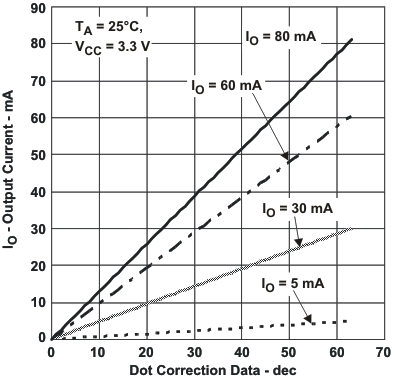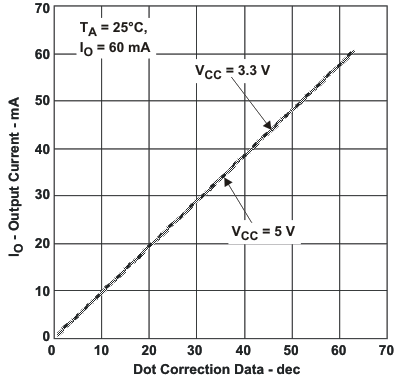SLDS165A December 2008 – December 2014 TLC5941-Q1
PRODUCTION DATA.
- 1 Features
- 2 Applications
- 3 Description
- 4 Revision History
- 5 Pin Configuration and Functions
- 6 Specifications
- 7 Parameter Measurement Information
- 8 Detailed Description
- 9 Application and Implementation
- 10Power Supply Recommendations
- 11Layout
- 12Device and Documentation Support
- 13Mechanical, Packaging, and Orderable Information
Package Options
Mechanical Data (Package|Pins)
- PWP|28
Thermal pad, mechanical data (Package|Pins)
Orderable Information
6 Specifications
6.1 Absolute Maximum Ratings
over operating free-air temperature range (unless otherwise noted)(1)| MIN | MAX | UNIT | ||
|---|---|---|---|---|
| Input voltage, VI(2) | VCC | –0.3 | 6 | V |
| V(BLANK), V(SCLK), V(XLAT), V(MODE), V(SIN), V(GSCLK), V(IREF), V(TEST) | –0.3 | VCC + 0.3 | ||
| Output voltage, VO | V(SOUT), V(XERR) | –0.3 | VCC + 0.3 | V |
| V(OUT0) to V(OUT15) | –0.3 | 18 | ||
| Output current (DC), IO | 90 | mA | ||
| Operating junction temperature, TJ(max) | 150 | °C | ||
| Storage temperature, Tstg | –55 | 150 | ||
(1) Stresses beyond those listed under absolute maximum ratings may cause permanent damage to the device. These are stress ratings only, and functional operation of the device at these or any other conditions beyond those indicated under recommended operating conditions is not implied. Exposure to absolute maximum rated conditions for extended periods may affect device reliability.
(2) All voltage values are with respect to network ground terminal.
6.2 ESD Ratings
| VALUE | UNIT | |||||
|---|---|---|---|---|---|---|
| V(ESD) | Electrostatic discharge | Human body model (HBM), per AEC Q100-002(1) | ±2000 | V | ||
| Charged device model (CDM), per AEC Q100-011 | Corner pins (1, 14, 15, and 28) | ±750 | ||||
| Other pins | ±500 | |||||
(1) AEC Q100-002 indicates HBM stressing is done in accordance with the ANSI/ESDA/JEDEC JS-001 specification.
6.3 Recommended Operating Conditions
| MIN | MAX | UNIT | |||
|---|---|---|---|---|---|
| DC CHARACTERISTICS | |||||
| VCC | Supply voltage | 3 | 5.5 | V | |
| VO | Voltage applied to output (OUT0–OUT15) | 17 | V | ||
| VIH | High-level input voltage | 0.8 VCC | VCC | V | |
| VIL | Low-level input voltage | GND | 0.2 VCC | V | |
| IOH | High-level output current | VCC = 5 V at SOUT | –1 | mA | |
| IOL | Low-level output current | VCC = 5 V at SOUT, XERR | 1 | mA | |
| IOLC | Constant output current | OUT0 to OUT15 | 60 | mA | |
| TJ | Operating junction temperature | –40 | 125 | °C | |
| AC CHARACTERISTICS | |||||
| f(SCLK) | Data shift clock frequency | SCLK | 30 | MHz | |
| f(GSCLK) | Grayscale clock frequency | GSCLK | 30 | MHz | |
| twh0/twl0 | SCLK pulse duration | SCLK = H/L (see Figure 12) | 16 | ns | |
| twh1/twl1 | GSCLK pulse duration | GSCLK = H/L (see Figure 12) | 16 | ns | |
| twh2 | XLAT pulse duration | XLAT = H (see Figure 12) | 20 | ns | |
| twh3 | BLANK pulse duration | BLANK = H (see Figure 12) | 20 | ns | |
| tsu0 | Setup time | SIN to SCLK↑ (see Figure 12) | 5 | ns | |
| tsu1 | Setup time | SCLK↓ to XLAT↑ (see Figure 12) | 10 | ns | |
| tsu2 | Setup time | MODE↑↓ to SCLK↑ (see Figure 12) | 10 | ns | |
| tsu3 | Setup time | MODE↑↓ to XLAT↑ (see Figure 12) | 10 | ns | |
| tsu4 | Setup time | BLANK↓ to GSCLK↑ (see Figure 12) | 10 | ns | |
| tsu5 | Setup time | XLAT↑ to GSCLK↑ (see Figure 12) | 30 | ns | |
| th0 | Hold time | SCLK↑ to SIN (see Figure 12) | 3 | ns | |
| th1 | Hold time | XLAT↓ to SCLK↑ (see Figure 12) | 10 | ns | |
| th2 | Hold time | SCLK↑ to MODE↑↓ (see Figure 12) | 10 | ns | |
| th3 | Hold time | XLAT↓ to MODE↑↓ (see Figure 12) | 10 | ns | |
| th4 | Hold time | GSCLK↑ to BLANK↑ (see Figure 12) | 10 | ns | |
6.4 Thermal Information
| THERMAL METRIC(1) | TLC5941-Q1 | UNIT | |
|---|---|---|---|
| PWP | |||
| 28 PINS | |||
| RθJA | Junction-to-ambient thermal resistance(2)(3) | 36.7 | °C/W |
| RθJC(top) | Junction-to-case (top) thermal resistance | 18.9 | |
| RθJB | Junction-to-board thermal resistance | 15.9 | |
| ψJT | Junction-to-top characterization parameter | 0.6 | |
| ψJB | Junction-to-board characterization parameter | 15.8 | |
| RθJC(bot) | Junction-to-case (bottom) thermal resistance | 2.3 | |
(1) For more information about traditional and new thermal metrics, see the IC Package Thermal Metrics application report, SPRA953.
(2) The package thermal impedance is calculated in accordance with JESD 51-7.
(3) With PowerPAD soldered on PCB with 2-oz trace of copper. For further information see the TI application report, PowerPAD™ Thermally Enhanced Package, SLMA002.
6.5 Electrical Characteristics
VCC = 3 V to 5.5 V, TJ = –40°C to 125°C (unless otherwise noted)| PARAMETER | TEST CONDITIONS | MIN | TYP | MAX | UNIT | |
|---|---|---|---|---|---|---|
| VOH | High-level output voltage | IOH = –1 mA, SOUT | VCC – 0.5 | V | ||
| VOL | Low-level output voltage | IOL = 1 mA, SOUT | 0.5 | V | ||
| II | Input current | VI = VCC or GND, BLANK, TEST, GSCLK, SCLK, SIN, XLAT |
–1 | 1 | μA | |
| VI = GND, MODE pin | –1 | 1 | ||||
| VI = VCC, MODE pin | 50 | |||||
| ICC | Supply current | No data transfer, all output OFF, VO = 1 V, R(IREF) = 10 kΩ |
0.9 | 6 | mA | |
| No data transfer, all output OFF, VO = 1 V, R(IREF) = 1.3 kΩ |
5.2 | 12 | ||||
| Data transfer 30 MHz, all output ON, VO = 1 V, R(IREF) = 1.3 kΩ |
16 | 25 | ||||
| Data transfer 30 MHz, all output ON, VO = 1 V, R(IREF) = 640 Ω |
30 | 60 | ||||
| IO(LC) | Constant output current | All output ON, VO = 1 V, R(IREF) = 640 Ω | 54 | 61 | 69 | mA |
| Ilkg | Leakage output current | All output OFF, VO = 15 V, R(IREF) = 640 Ω, OUT0 to OUT15 |
0.1 | μA | ||
| ΔIO(LC0) | Constant sink current error | All output ON, VO = 1 V, R(IREF) = 640 Ω, OUT0 to OUT15, TA = –20°C to 85°C(2) |
±1% | ±4% | ||
| All output ON, VO = 1 V, R(IREF) = 640 Ω, OUT0 to OUT15(2) |
±1% | ±8% | ||||
| ΔIO(LC1) | Constant sink current error | Device to device, averaged current from OUT0 to OUT15,R(IREF) = 1920 Ω (20 mA)(3) |
0.4% | ±4% | ||
| ΔIO(LC2) | Line regulation | All output ON, VO = 1 V, R(IREF) = 640 Ω, OUT0 to OUT15, VCC = 3 V to 5.5 V(4) |
±1 | ±4 | %/V | |
| ΔIO(LC3) | Load regulation | All output ON, VO = 1 V to 3 V, R(IREF) = 640 Ω, OUT0 to OUT15(5) |
±2 | ±6 | %/V | |
| T(TEF) | Thermal error flag threshold | Junction temperature(1) | 150 | 170 | °C | |
| V(LED) | LED open detection threshold | 0.3 | 0.4 | V | ||
| V(IREF) | Reference voltage output | RI(REF) = 640 Ω | 1.20 | 1.25 | 1.29 | V |
(1) Not tested. Specified by design.
(2) The deviation of each output from the average of OUT0-15 constant current. It is calculated by Equation 1 in Test Parameter Equations.
(3) The deviation of average of OUT0–OUT15 constant current from the ideal constant-current value. It is calculated by Equation 2 in Test Parameter Equations. The ideal current is calculated by Equation 3 in Test Parameter Equations.
(4) The line regulation is calculated by Equation 4 in Test Parameter Equations.
(5) The load regulation is calculated by Equation 5 in Test Parameter Equations.
6.6 Switching Characteristics
VCC = 3 V to 5.5 V, CL = 15 pF, TJ = –40°C to 125°C (unless otherwise noted)| PARAMETER | TEST CONDITIONS | MIN | TYP | MAX | UNIT | |
|---|---|---|---|---|---|---|
| tr0 | Rise time | SOUT | 16 | ns | ||
| tr1 | Rise time | OUTn, VCC = 5 V, TA = 60°C, DCn = 3Fh | 10 | 30 | ns | |
| tf0 | Fall time | SOUT | 16 | ns | ||
| tf1 | Fall time | OUTn, VCC = 5 V, TA = 60°C, DCn = 3Fh | 10 | 30 | ns | |
| tpd0 | Propagation delay time | SCLK to SOUT (see Figure 12) | 30 | ns | ||
| tpd1 | Propagation delay time | BLANK to OUT0 (see Figure 12) | 60 | ns | ||
| tpd2 | Propagation delay time | OUTn to XERR (see Figure 12) | 1000 | ns | ||
| tpd3 | Propagation delay time | GSCLK to OUT0 (see Figure 12) | 60 | ns | ||
| tpd4 | Propagation delay time | XLAT to IOUT (dot correction) (see Figure 12) | 1000 | ns | ||
| td | Output delay time | OUTn to OUT(n+1) (see Figure 12) | 20 | 30 | ns | |
| ton_err | Output on-time error | touton – tgsclk (see Figure 12), GSn = 01h, GSCLK = 11 MHz | 10 | –50 | –90 | ns |
6.7 Typical Characteristics








